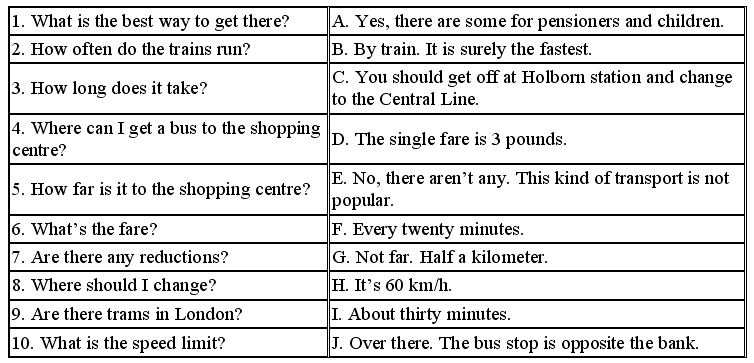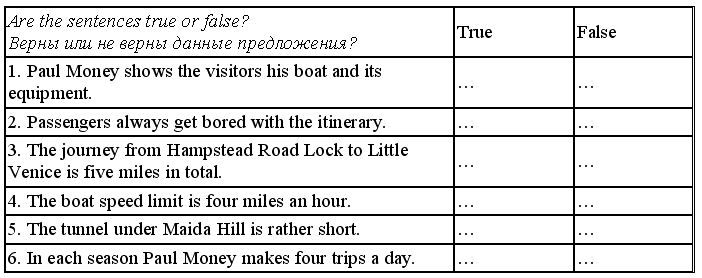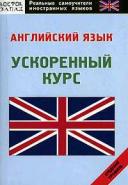Книга: Английский язык: самоучитель
READINGAND SPEAKING PRACTICE
READINGAND SPEAKING PRACTICE
1. Answer the questions.
Ответьте на вопросы.
1. Why do we sometimes avoid using public transport?
2. Why do we sometimes give up driving in the city centre?
3. Which is the best way to get around your town?
4. Which is the bus/taxi/train fare?
5. Do you have to change when you are going to work?
6. Which places in your town can you call fascinating? Why?
7. Why can your town attract visitors?
8. Do bus drivers sell tickets?
9. Do buses in your town usually run on time?
10. Why are we sometimes tired of driving?
2. Agree or disagree. Explain your ideas.
Согласитесь или опровергните данные суждения. Объясните своемнение.
1. People usually prefer travelling by train to travelling by plain.
2. Public transport is always packed.
3. We have to buy our bus tickets in a shop.
4. A weekly ticket is cheaper than a one-day ticket.
5. Going by an overland train is faster than by tube.
6. It isn’t worth while driving in the town centre.
7. There are now shopping centres not far from people’s home.
8. When people go to the theatre they try not to use public transport.
9. There is no way that people can get any reductions.
10. Bus drivers stop the bus only at the bus stops.
3. Order and read the dialogue. Try to learn it.
Расставьте реплики в правильной последовательности и прочитайте диалог. Постарайтесь его запомнить.

4. Match the questions to the answers.
Найдите подходящие по смыслу ответы.

5. Read the dialogue. Try to learn it.
Прочитайте диалог и постарайтесь выучить его.
Karl: How do we get to the museum?
Julia: First we go by bus and then we go by tube.
Karl: Tube? What’s that? You buy toothpaste in tubes.
Julia: The tube is another word for the underground.
Karl: Oh, I see. How far is it from the station to the museum?
Julia: Oh, not far. Half a kilometer.
Karl: And how long does it take?
Julia: From Holborn Station?
Karl: No, from here. The whole journey.
Julia: About three quarters of an hour.
Karl: In Munich I go everywhere by tram Are there trams in London?
Julia: No. My grandmother told me that there were trams when she was young. But not now. I don’t know why.
Karl: How often do these buses run?
Julia: Every ten minutes.
Karl: But you said it ten minutes ago. Come on, Julia. Let’s get a taxi.
Julia: Karl, taxis are expensive.
Karl: But it’s not far to the hotel. It won’t cost much.
6. Read this text.
Прочитайте текст.
Paul Money’s Canal Boat
Paul Money has a canal boat. He takes passengers and shows them the canal and its attractions.
They go from Little Venice down to Hampstead Road Lock. The journey down to Hampstead Road Lock is a distance of about two and a half miles, so that’s five miles in total. And the return journey takes one and a half hours.
The journey goes through the tunnel under Maida Hill, which is about 250 metres long. By canal standards it’s quite short, it’s one of the shorter tunnels on the system. Some tunnels go as much as three miles in length.
The fastest that the boat travels is about four and three quarter miles an hour, but the speed limit is actually four miles an hour. The journey makes its way around the north-west edge of Regent’s Park through the London Zoo. The passengers are always attracted by the animals and birds living here.
In the high summer they make four trips a day. The return fare for an adult is four pounds fifty, or a single fare three pounds fifty. Then there are reductions for children and pensioners.
Complete the sentences.
Закончите предложения.
1. The distance between Little Venice and Hampstead Road Lock is…………………………..
2. The way there and back takes about………………………………………………………….
3. The main attractions on the way are………………………………………………………….
4. Thee tunnel is………………………………………………………………………………..
5. The speed limit on the canal is………………………………………………………………
6. The return fare for an adult is………………………………………………………………..





